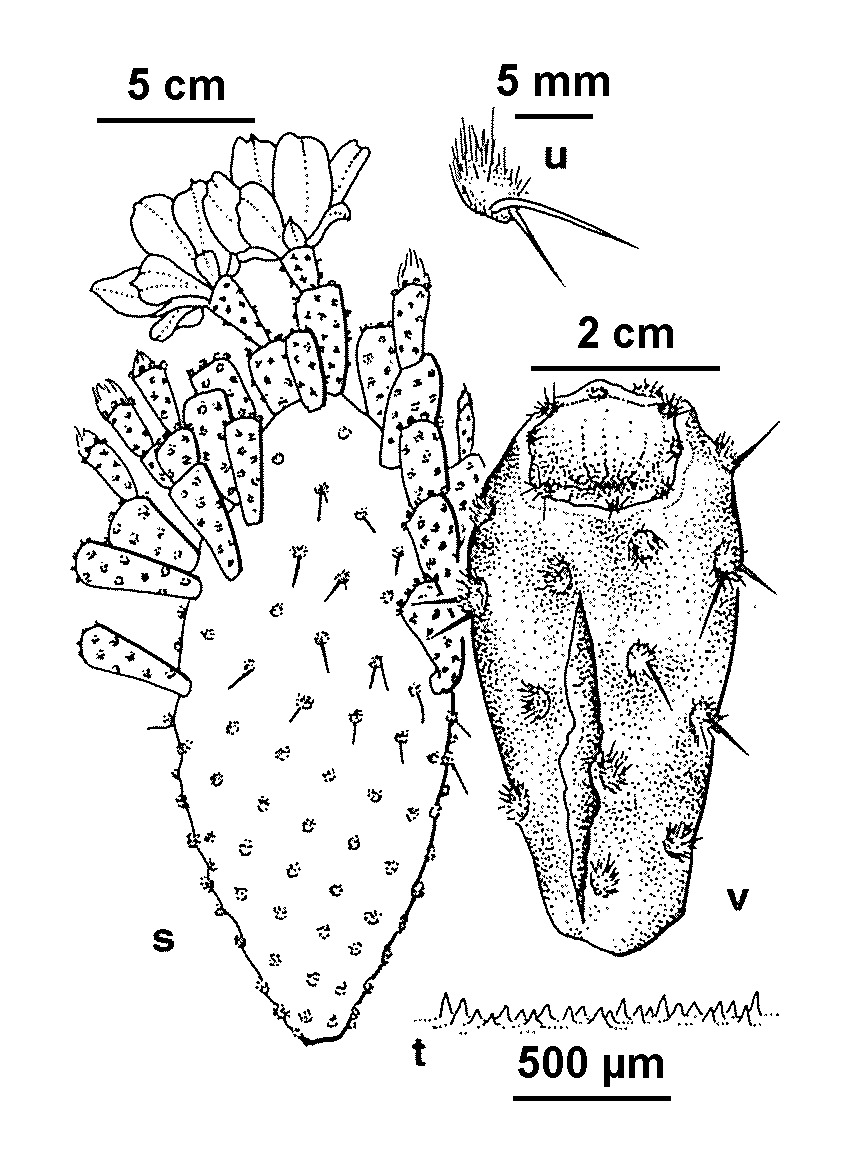Opuntia puberula
Pfeiff. Blind Prickly-pearSpreading to erect shrub, to 2 m high, trunk in older plants cylindric, to c. 70 cm high, 10 cm diam. Terminal cladodes compressed, elliptic to obovate, 9–22 cm long, (3.5–)5–10 cm wide, dull light green to mid green; minutely papillate (papillae to 0.1 mm long); areoles (25–)30–60 per cladode face, 10–25 mm apart, filled with yellowish glochids and pale brown wool; spines (0–)1–3 per areole, 5–17 mm long, 0.5–0.7 mm wide near base, pale yellow ageing white, usually deflexed, occasionally erect near apex of cladode. Flowers 5–7 cm diam.; sepaloids dull crimson-tinged; petaloids spreading, bright yellow (the outer crimson-tinged), mucronate; stamens pale yellow; style white, stigmas green; hypanthium more or less tuberculate. Fruit obovoid, rather deeply depressed at apex when young, 5–7 cm long, 2–3 cm diam., not tuberculate, minutely papillate, reddish-purple, with short deciduous spines. Fruits usually persisting and proliferating, rarely ripening, splitting longitudinally. Flowers late spring–summer.
MuM, Wim, VVP, VRiv, MuF, GipP, OtP. Also naturalised WA, SA, NSW, ACT. The country of origin of the plants naturalised in Australia is unknown. A weed mainly of road and railway verges, and abandoned gardens (e.g. Dimboola area, Bacchus Marsh, Melbourne suburbs, Mildura, Yarrawonga etc.).
The identity of this taxon and the application of the name as used here is uncertain. The name Opuntia puberula is commonly applied to the plants that are cultivated and naturalised in Europe, U.S.A, and Australia. Telford (1984) did not provide a name for this entity, and suggested that it might represent Opuntia lubrica Griffiths, which is now treated as a synonym of O. microdasys. O. microdasys differs in having a minutely pubescent cladode surface, and lack spines. Harden (1990) employed the name O. tenuispina Engel., with the comment that O. tenuispina may be included in Opuntia sp. of Telford (1984). However, O. tenuispina is a synonym of O. macrorhiza, a rather different looking species, which forms low clumps to 13 cm high, and has much longer spines. Stajsic and Carr (1996) provisionally applied the name O. puberula, with reservation, noting that Australian plants differ from O. puberula in having a minutely muricate stem segment surface rather than being pubescent. Anderson (2001) notes that O. puberula is closely related to O. decumbens, and both species were maintained by Hunt et al. (2006). More recently, Arias et al. (2012) treat O. puberula as a synonym of O. decumbens, without providing any explanation. It is possible that the Australian plants represent a hybrid taxon, possibly involving O. microdasys (Lehm.) Pfeiff.
Stajsic, V.; Carr, G. W. (1996). Cactaceae. In: Walsh, N.G.; Entwisle, T.J., Flora of Victoria Vol. 3, Dicotyledons Winteraceae to Myrtaceae, pp. 119–129. Inkata Press, Melbourne.
 Spinning
SpinningSynonyms
Anderson, E.F. (2001). The Cactus Family. Timber Press.
Arias, S.; Gama-López, S.; Ulises Guzmán-Cruz, L.; Vázquez-Benítez, B. (2012). Flora del Valle de Tehuacán-Cuicatlán. Fascículo 95. Cactaceae Juss. , edn 2nd. Inst. Biol. Univ. Nac. Aut. México.




